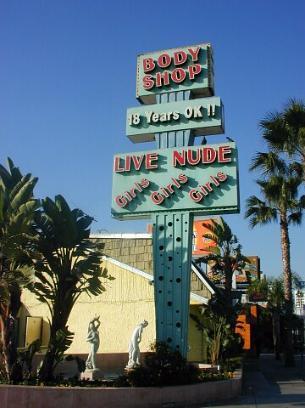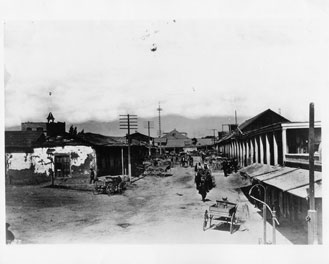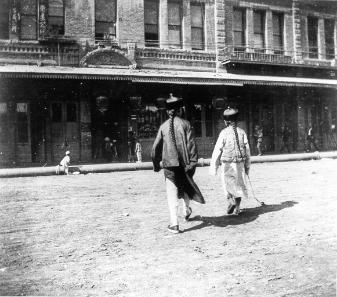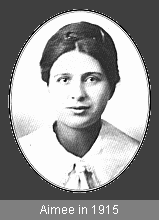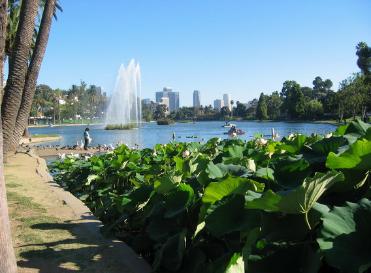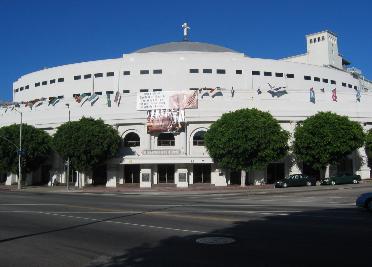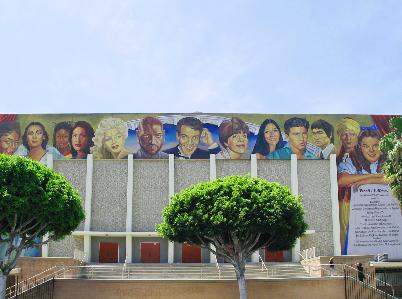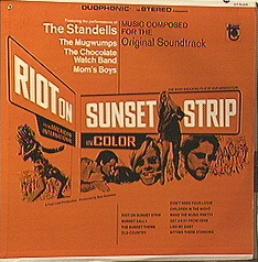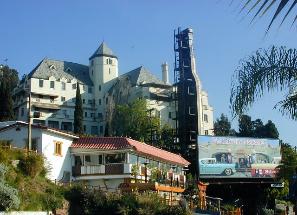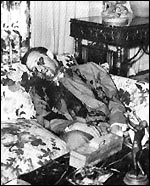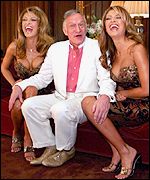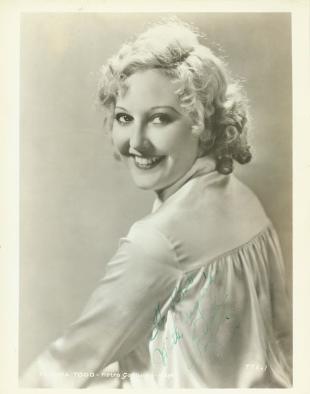Sunset Boulevard
by Will Kern
Old Chinatown.
The lotus pond at Echo Park.
Angelus Temple.
True or not, Sister Aimee's walk on the
wild side is pretty tame by today's
standards. She never stole from any
of her parishioners and didn't have a
lavish lifestyle. According to
biographer Don Taylor, her temple fed
tens of thousands during the
depression, and when the government
shut down the school lunch program,
Sister Aimee took it over.
|
Hollywood High School, alma mater of all-of-the-above,
and then some.
The soundtrack to the movie based on the riot.
Chateau Marmont is reportedly haunted by the ghost
of actor John Belushi, who died of a drug overdose
in one of its bungalows in 1982.
Mobster Mickey Cohen, The King of the Sunset Strip.
Cohen was a lieutenant for Benjamin "Bugsy" Siegel
(below), who was murdered in his Beverly Hills home.
Hugh Hefner (above)
and Lyle and Eric
Menendez (right)
lived near each
other in Bel Air.
The beautiful actress Thelma Todd. There are many
unanswered questions in her mysterious death. Was
she the victim of a gang hit? And was the notoriously
corrupt LA Coroner's Office part of a cover up?
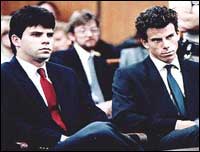
Sunset Boulevard is the city of LA in
all her dirty-legged glory: tempting,
violent, empty, opulent, bitter, corrupt,
phony, self-obsessed, cruel. The milk
of human meanness. The hooker with
the heart of tar.
She slags along for nearly 23 miles
and is LA's second longest street, after
Sepulveda Boulevard, which beats it by
three miles. It starts downtown, winds
its way through graffiti strewn concrete
overpasses, broken glass, stray dogs,
and poor neighborhoods in Echo Park
and Silver Lake, then goes through
faded Hollywood, over the gaudy and
dazzling Sunset Strip, in and out of the
mansions of Beverly Hills and Bel-Air,
through Pacific Palisades, and finally
dead ends at the Pacific Ocean.
Start downtown and head west into
some of LA's most historical places.
And hotspots from a tortured past.
THE CHINATOWN MASSACRE
Just a block from where Sunset
Boulevard originally started (this short
stretch has since been renamed Cesar
E. Chavez Avenue, after the civil rights
leader) LA's Old Chinatown once stood
where Union Station is now.
Buried deep under the glimmering
floor of the station's Spanish red tile
are the ruins of the back alleys, opium
dens, brothels, mah-jongg parlors and
flop houses that made up this
neighborhood and ran it like a greasy
clock.
This was before the turn of the
century. Back then, when LA was just a
hodgepodge of muddy little enclaves
with a population of about 5,000,
Chinese gangs, called tongs, were
fighting it out tooth and nail to control
city vice, which was centered in
Chinatown. For the most part, the
police didn't intervene. This was, after
all, Chinese business. And there was
money to be made from kickbacks.
But on October 24, 1871, LA got its
first taste of real blood when Sam Yuen
and Yo Hing, members of two opposing
tongs, started a fight over a girl that
quickly spread into gang war. A white
cop named Robert Thompson tried to
break it up but was shot and killed.
What followed was vigilante
injustice. Word spread quickly and a
white mob set on the place. A dozen
whites, including the local sheriff, tried
to calm the crowd but it was no use. In
five hours, 19 Chinese men and boys
had been murdered, 15 of them
lynched.
This tragic incident was dubbed "The
Chinatown Massacre" by newspapers
across the country and was LA's first
big headline. If she were trying to
establish a reputation for scandal, she
would not let her public down.
NOT SO SEMPLE AIMEE
Pentecostal evangelist Aimee Semple
McPherson was so popular in the early
1920s that she sometimes played to
crowds of 16,000 – three times a day!
Sister Aimee, as she was known to the
faithful, moved to LA in 1919 and
decided to build her church next to a
lotus pond in Echo Park, near the cross
streets of Sunset and Park Avenue.
She raised a million dollars in two
years, and on New Year's Day, 1923,
her Church of the Four Square Gospel,
also called Angelus Temple, opened its
doors. The temple quickly became the
city's top tourist attraction. Life was
good.
But all that came crashing down when,
three years later, on May 18, 1926, she
disappeared while swimming off Ocean
Park. There was an extravagant and
well-attended memorial service – and
then three days later she showed up in
a Mexican border town, wild-eyed and
babbling, telling stories of rape,
kidnapping, and torture. She was
quickly accepted back into the fold, but
the press, once so much her champion,
turned against her when it was
discovered she had been having an
affair with Kenneth Ormiston, her radio
engineer – and a married man!
Then Ormiston's wife, a woman
named Lorraine Wiseman, told police
that Aimee and her mother Minnie had
paid her off to be part of the kidnapping
hoax. They were both charged with
"criminal conspiracy to commit acts
injurious to public morals and to
prevent and obstruct justice" but the
case was dropped before it could come
to trial.
Seemingly vindicated, she went back
to the pulpit, but to this day no one
knows the truth as to what exactly
happened that day back in 1926. What
she kidnapped? Or was she shacking
up in a "love nest" with her married
boyfriend? We'll never know, and even
Foursquare's official website won't say
for sure...
MELEES, RIOTS, AND GANGSTERS
Check out Echo Park at Sunset and
Park Avenue, then drive west into Silver
Lake. On the right, at 3909 Sunset, is
a gay bar called Le Barcito. Back in
the 60s it was The Black Cat, and the
scene of a notorious rumble in this
concrete jungle.
On New Year's Eve, 1967, the place
was packed, and the bar's patrons,
many in drag, were ringing in the
holiday. Others in the crowd were
incognito vice cops. At the stroke of
midnight, kisses were exchanged, as
they often are at midnight on New
Year's, and the cops started busting up
the place. This turned into a free for all
that spilled out into the street and into
the gay bar next door. The billy clubs
came out, blood started flowing and the
bartender was beaten so violently he
was hospitalized for over a week.
From Le Barcito, continue west into
Hollywood, the used-to-be capital of
movies. On the right at 6525 Sunset
Blvd is the Hollywood Athletic Club, a
once thriving celebrity hang out where
John Wayne used to get drunk and
throw pool balls out the window at
passing cars. A few blocks up at
Sunset and Highland Avenue is
Hollywood High School, the alma mater
of such luminaries as Carol Burnett,
Laurence Fishburne, Judy Garland,
Mickey Rooney, Manson prosecutor
Vincent Bugliosi, former Secretary of
State Warren Christopher, and many
others. Keep going to Crescent
Heights, the official start of the Sunset
Strip. Here, the billboards are bigger
and more ostentatious. The starting
price is $30K per month to rent.
This is also the intersection where,
on the night of November 13, 1966, the
infamous "Riot on the Sunset Strip"
occurred when disaffected youth
clashed with police over the closing of a
popular coffee house called Pandora's
Box. It was supposed to be a peaceful
demonstration, with guitar playing and
singing and flower power, but it quickly
turned into the wild wild west with
shouting and buses being overturned
and the cops moving in and
pandemonium. Some 300 were
arrested.
On the right is the hotel Chateau
Marmont, that has the dubious
distinction of being where both comic
actor John Belushi and photographer
Helmut Newton died, from drugs and a
car accident, respectively; up the street
on the left is the Viper Room, a
nightclub owned by the actor Johnny
Depp. Actor River Phoenix OD'ed on
the sidewalk out front on Halloween
night, 1993.
Sunset is also where Mickey Cohen,
a nattily dressed gangster known as
"The King of the Sunset Strip," was
nearly shot to death – twice.
Cohen was a lieutenant in Bugsy
Siegel's army, and took over mob
operations in the mid-1940s when
Siegel left for Vegas to open the
Flamingo. He opened a haberdashery
on the strip – featuring hats and coats
in only his size – as a front for his loan
sharking, gambling, and bookmaking
interests. He was making $80K a
month. In 1940s dough.
A rival gangster named Jack Dragna
put a contract out on the dapper hood,
and in 1948, three goombahs walked
into the haberdashery and shot the
place to hell. A bodyguard was killed,
but Cohen survived. He was in the
restroom washing his hands, which he
did on average 50 times a day. Cohen
had a very severe case of obsessive-
compulsive disorder, and while it can
often be debilitating and excruciating,
that time it saved his life.
The attempted murder touched off
"The Sunset Wars." Two more
attempts were made on Cohen, one
when Dragna's men set off a bomb
under his bed (he wasn't home at the
time) and another shooting attempt
outside Sherry's restaurant at 9039
Sunset. This one left another
bodyguard dead and Cohen with his
arm almost blown off – but alive.
His time was running out, however.
He was convicted of tax evasion twice
and did two long stretches in prison.
He was released in 1972 and died of
stomach cancer in 1976. Sherry's
Restaurant, the scene of the second
shooting, is still there, but now it's a
rock club called Gazzari's.
MURDER BY THE OCEAN
Continue driving west, and the tall
buildings and billboards of the Sunset
Strip give way to the manicured lawns
and high fences of Beverly Hills and Bel-
Air. Here, the tall thin palm trees look
like anorexic actresses, their palm
fronds a mixture of tired dead brown
and youthful exuberant green. There
isn't a lot to be seen here as most of
the action is tucked away, but two
scandalous places of note are the
Menendez House, at 722 Elm Drive,
just south of Sunset, where Lyle and
Erik Menendez murdered their parents;
and the Playboy Mansion, at 10236
Charing Cross Road, also south of
Sunset, where all kinds of craziness
happens, and has since The World's
Oldest Juvenile moved here from
Chicago in 1971.
Sunset Boulevard ends at the Pacific
Ocean, in time for one final scandal.
Thelma Todd, the popular comedic
actress back from the 20s and 30s,
best known for her work in the Marx
Brothers' Monkey Business and Horse
Feathers, owned a little hotspot named
Thelma Todd's Sidewalk Café at 17575
Pacific Coast Highway, near the
intersection of Sunset and PCH in
Pacific Palisades.
On the night of December 15, 1935,
Todd and her lover, film producer
Roland West, were heard having a loud
argument after he returned from a
party in Hollywood. The next morning,
her lifeless body was found in her
garage above the cafe, slumped over
her car's steering wheel. The garage
doors were closed and the motor was
still running. It looked like a suicide, but
where was the note? The coroner
ruled her death an accident by carbon
monoxide poisoning.
But there were many questions. Her
face was bloodied, and there were
blood spots on and in the car. Were
they hers? There was a smudged
handprint found on the car door.
Whose was it? How did it get there?
She was wearing jewels and furs.
Why? If she was going somewhere,
where was she going? It was rumored
that gangster Lucky Luciano had been
leaning on her to open a casino in her
café, but she refused. Could it have
been a gang hit?
The police couldn't pin the murder
on boyfriend West, and the Los
Angeles County District Attorney's
Office, known for its corruption in those
days, did a perfunctory investigation
and it was quickly closed. How Thelma
Todd really died, and why, is a case as
cold as the grave and seems destined
to remain unsolved.
As are many mysteries in this dirty
old town. Yet if one thing is certain, it's
this: Sunset Boulevard, from its
easternmost point in Old Chinatown to
the bluffs in Pacific Palisades, will
always be LA's street of scandal, it's
drag of darkness, its highway to hell.
Which is perfect, considering. This
place is called the City of Angels. That
doesn't mean all the angels are holy.
